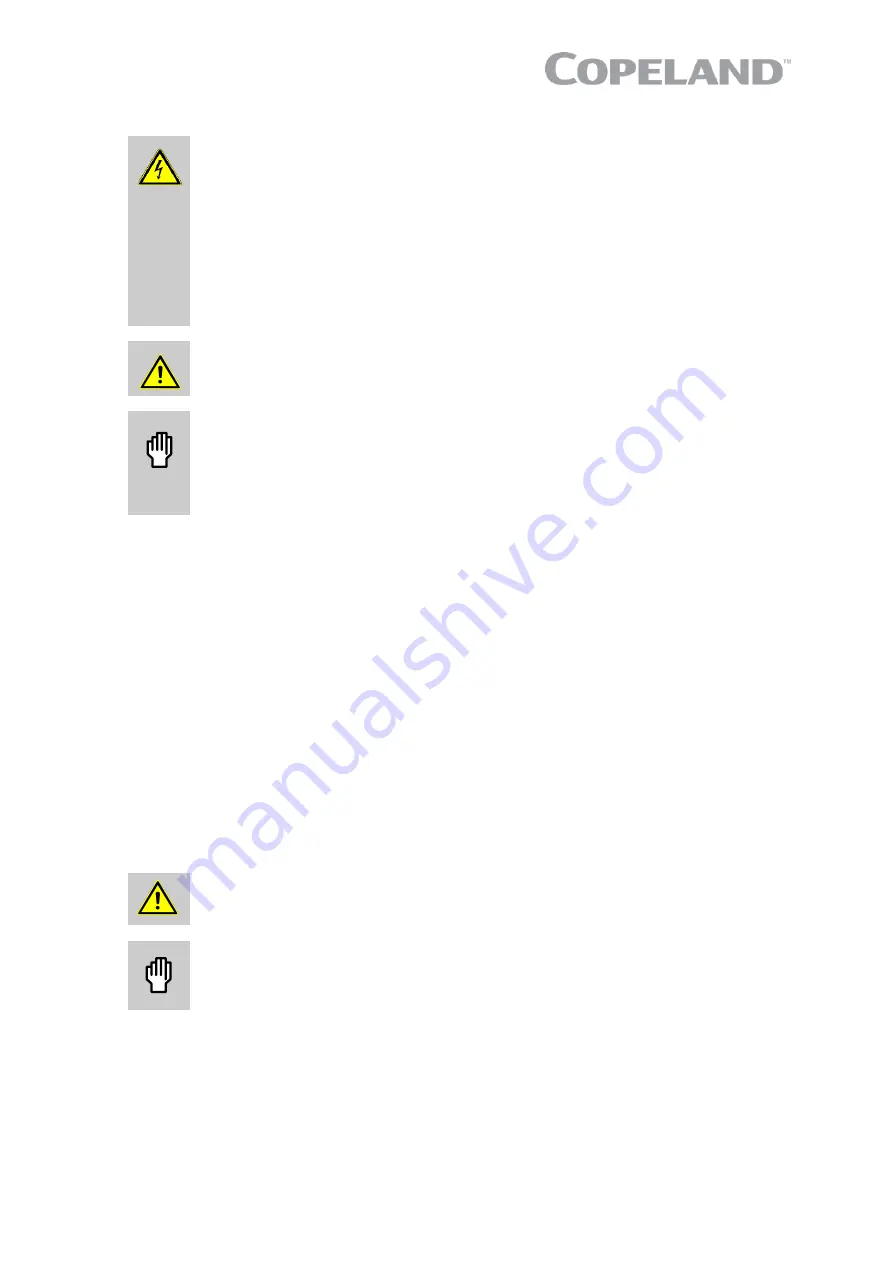
C6.1.11/0718-0619/E
47
5.2 Replacing a compressor
WARNING
Isolating switch "On"! Danger of electric shock!
Turn off the main power
supply to de-energise the unit before undertaking any task on electrical
equipment.
High voltage! Danger of electric shock!
There is a risk of electric shock if
mains-supplied equipment is disconnected and the wire ends are open. In this
case the open ends may carry a potentially lethal voltage until the internal
capacitors have discharged. This can take up to 10 minutes.
Compressor e-box cover open! Danger of electric shock!
Always make
sure that the compressor e-box cover is properly closed before restarting the
unit.
WARNING
Toxic fumes! Danger of suffocation!
In case of fire toxic fumes can be
released by burning non-metallic parts. Avoid inhaling the fumes.
CAUTION
Inadequate lubrication! Bearing destruction!
Exchange the accumulator (if
present in the system) after replacing a compressor with a burned-out motor.
The accumulator oil return orifice or screen may be plugged with debris or may
become plugged. This will result in starvation of oil to the new compressor and
a second failure.
In the case of a motor burnout, most contaminated oil will be removed with the compressor. The rest
of the oil is cleaned by means of a liquid line filter drier. A 100% activated alumina suction line filter
drier is recommended but must be removed after 72 hours.
It is highly recommended to replace
the suction accumulator, if the system contains one.
This is because the accumulator oil return
orifice or screen may be plugged with debris or may become plugged shortly after a compressor
failure. This will result in starvation of oil to the replacement compressor and a second failure. When
a compressor is exchanged in the field, it is possible that a major portion of the oil may still be in the
system. While this may not affect the reliability of the replacement compressor, the extra oil will add
to rotor drag and increase power usage.
▪
Before any intervention, de-energize the refrigeration unit and allow for the capacitors in the drive
to discharge; this can take up to 10 minutes.
▪
Close valves to isolate the unit from the system.
▪
Recover the refrigerant from the unit and make sure that the compressor is not under pressure.
▪
Release the compressor mounting parts then lift it to replace with a new compressor.
NOTE: For more detailed instructions, please refer to the compressor application guidelines.
5.3 Condenser fins
CAUTION
Sharp condenser fins! Personal injuries!
Be careful when cleaning the
condenser fins. Always use protective gloves and an appropriate brush.
CAUTION
Acid cleaning! Corrosion of condenser fins!
Do not use acidic solutions to
clean the coil. After cleaning, the fins should be brushed lightly with a proper
fin comb.
Condenser fins become dirty over time as ambient air is induced to the condenser. Dirty coil surfaces
result in high condensing temperatures and poor unit performance. Regular cleaning is
recommended, the frequency of doing so being dependent on the installation and the surrounding
environment. As a general guide, it is advisable to do this at least once every two months.
As a general rule and for a clean environment Emerson recommends that the fins be cleaned with
liquid detergent diluted with clean water. The refrigeration unit has a well-designed chassis with
falling levels towards a large drainage hole, and provided the unit is installed level, any cleaning
solution should be able to drain away. A light brush downward (in the direction of the fins) should be
done before washing to remove heavy deposits.
Summary of Contents for Copeland EazyCool OME-4MTL-09X
Page 1: ...Copeland Eazycool CO2 Refrigeration Units Application Guidelines ...
Page 5: ......
Page 68: ...C6 1 11 0718 0619 E 63 ...
















































